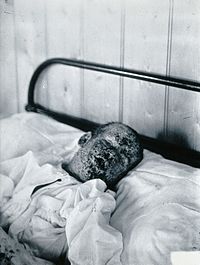
Photo from wikipedia
Background Brachygnathia, cardiomegaly and renal hypoplasia syndrome (BCRHS, OMIA 001595–9940 ) is a previously reported recessively inherited disorder in Australian Poll Merino/Merino sheep. Affected lambs are stillborn with various congenital… Click to show full abstract
Background Brachygnathia, cardiomegaly and renal hypoplasia syndrome (BCRHS, OMIA 001595–9940 ) is a previously reported recessively inherited disorder in Australian Poll Merino/Merino sheep. Affected lambs are stillborn with various congenital defects as reflected in the name of the disease, as well as short stature, a short and broad cranium, a small thoracic cavity, thin ribs and brachysternum. The BCRHS phenotype shows similarity to certain human short stature syndromes, in particular the human 3M syndrome-2. Here we report the identification of a likely disease-causing variant and propose an ovine model for human 3M syndrome-2. Results Eight positional candidate genes were identified among the 39 genes in the approximately 1 Mb interval to which the disease was mapped previously. Obscurin like cytoskeletal adaptor 1 ( OBSL1 ) was selected as a strong positional candidate gene based on gene function and the resulting phenotypes observed in humans with mutations in this gene. Whole genome sequencing of an affected lamb (BCRHS3) identified a likely causal variant ENSOARG00000020239:g.220472248delC within OBSL1 . Sanger sequencing of seven affected, six obligate carrier, two phenotypically unaffected animals from the original flock and one unrelated control animal validated the variant. A genotyping assay was developed to genotype 583 animals from the original flock, giving an estimated allele frequency of 5%. Conclusions The identification of a likely disease-causing variant resulting in a frameshift (p.(Val573Trpfs*119)) in the OBSL1 protein has enabled improved breeding management of the implicated flock. The opportunity for an ovine model for human 3M syndrome and ensuing therapeutic research is promising given the availability of carrier ram semen for BCRHS.
Journal Title: BMC Genetics
Year Published: 2020
Link to full text (if available)
Share on Social Media: Sign Up to like & get
recommendations!